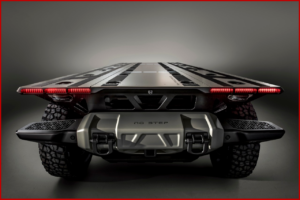 General Motors in an active and thus far unsuccessful “pump up the moribund stock price with press releases” claims today that it will solve some of the transportation challenges created by natural disasters, complex logistics environments and global conflicts. The company will display its Silent Utility Rover Universal Superstructure (SURUS), a flexible fuel cell electric platform with autonomous capabilities, at the fall meeting of the Association of the United States Army (AUSA) from Oct. 9-11, 2017. The commercially designed platform could be adapted for military use. ***
General Motors in an active and thus far unsuccessful “pump up the moribund stock price with press releases” claims today that it will solve some of the transportation challenges created by natural disasters, complex logistics environments and global conflicts. The company will display its Silent Utility Rover Universal Superstructure (SURUS), a flexible fuel cell electric platform with autonomous capabilities, at the fall meeting of the Association of the United States Army (AUSA) from Oct. 9-11, 2017. The commercially designed platform could be adapted for military use. ***
SURUS uses GM’s newest Hydrotec prototype fuel cell, with claimed autonomous capability and truck chassis components to deliver high-performance, zero-emission propulsion to minimize logistical burdens and reduce human exposure to harm. Claimed benefits include quiet and odor-free operation, off-road mobility, field configuration, instantaneous high torque, exportable power generation, water generation and quick refueling times.

Partnerships remain an important part of GM’s electrification strategy that appears dependent on taxpayer subsidies, an industry-wide practice.
Fuel cell technology is a key piece of General Motors’ zero emission strategy, although the Japanese and Koreans have fuel cells in production and for lease to civilians. GM said it offers a solution that can scale to larger vehicles with large payload requirements and operate over longer distances.
SURUS was designed to form a foundation for a family of commercial vehicle solutions that leverages a single propulsion system integrated into a common chassis. The SURUS platform is designed for adaptation to military environments where users can take advantage of flexible energy resources, field configuration and improved logistical characteristics.
GM is evaluating multiple applications for SURUS:
- Utility trucks
- Mobile and emergency backup power generation
- Flexible cargo delivery systems
- Commercial freight
- Light- and medium-duty trucks, improving upon the Chevrolet Colorado ZH2 that has been evaluated by the U.S. military under guidance of the U.S. Army Tank Automotive Research, Development and Engineering Center (TARDEC) and is undergoing testing on bases
- Future military-specific configurations
SURUS in theory can deliver autonomous capability and agility in unpredictable terrain. Operating multiple vehicles in a leader-follower configuration could reduce manpower needed. For future potential military uses, the system’s inherent low heat signature and quiet operation offer benefits in environments to reduce detection and risks. TARDEC has been in discussions with GM evaluating the commercial SURUS concept as a next step of the broader collaboration to evaluate fuel cell technology for future military applications.
“SURUS redefines fuel cell electric technology for both highway and off-road environments,” claimed Charlie Freese, executive director of GM Global Fuel Cell Business.
The SURUS platform uses GM’s non-production experience in fuel cell technology, high-voltage batteries and electric drive systems, autonomous driving and vehicle manufacturing.
Platform
- Two electric drive units
- Four-wheel steering
- Lithium-ion battery system
- Gen 2 fuel cell system
- Hydrogen storage system capable of more than 400 miles of range
- Advanced propulsion power electronics
- GM truck chassis components
- An advanced suspension
Hydrotec
Since April 2017, the Army has been testing the commercial Chevrolet Colorado ZH2 on its U.S. bases to determine the viability of hydrogen-powered vehicles in military mission tactical environments. The vehicle has been operating in off-road conditions to evaluate its power generation, reduced odor, acoustic and thermal signatures, high wheel torque, extended operating range and the potential to use the byproduct water.
Military testing has shown the ZH2 reduced acoustic non-detection distance by 90%compared to current military vehicle in operation. This means the ZH2 can get 10 times closer before being detected. Leaders also observed the potential advantages for stationary power generation over diesel generators, including a significant reduction in idle noise and fuel use. Testing will continue through spring 2018.
Partnerships remain an important part of GM’s electrification strategy that appears dependent on taxpayer subsidies – an industry wide practice. Last year, the U.S. Navy unveiled a GM fuel cell-powered Unmanned Undersea Vehicle (UUV) for testing purposes that uses GM fuel cell technology common with the Colorado ZH2.
***AutoInformed.com on Fuel Cells
- Toyota, 7-Eleven Japan to Study Fuel Cell Trucks
- Canada Moves Ahead on Fuel Cell Vehicles
- Toyota to Use Hydrogen Fuel Cells for Zero Emission Trucking
- Hydrogen Fuel Cell Vehicles Grow Three-Fold in 2016
- GM and Honda to Make Fuel Cells in Michigan
- Mirai Hydrogen Fuel Cell Tests in United Arab Emirates in May
- 2017 Honda Clarity Fuel Cell Deliveries Start
- Toyota to Sell Fuel Cell Buses in Japan Next Year
- Chevrolet Colorado ZH2 Fuel Cell Ready for Army Testing
- Army, GM to Show Colorado-Based Fuel Cell EV
- Fuel Cell Pricing Wars – 2017 Hyundai Tucson, Toyota Mirai
- Toyota Mirai Fuel Cell Range 312 Miles Says EPA
- 70 Tucson Fuel Cell Vehicles Run 500,000 Miles in California
- Toyota Says 1500 Japanese Orders for Mirai Fuel Cell Car
- Hydrogen Bomb! Toyota Opens Its Fuel Cell Patents for Industry Use
- Tucson Fuel Cell EV $499 Month Next Spring
- Honda Fuel Cell Concept Debuts at Los Angeles Auto Show
- Fuel Cell Faceoff in LA – Honda v Toyota
- Toyota to Retail Hydrogen Fuel Cell Hybrids in U.S. by 2015
- BMW and Toyota Sign Deal for Joint Fuel Cell and Battery Programs
- Daimler and Honda Lead in Car Fuel Cell Development, Maybe
- World First – Suzuki Fuel Cell Motorcycle Street Legal in EU

